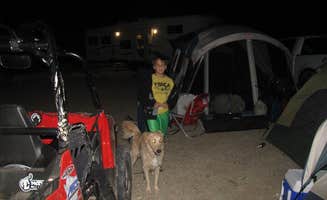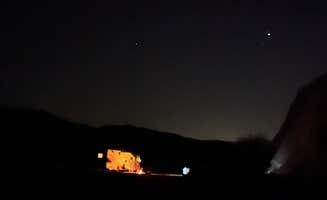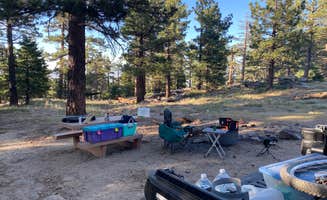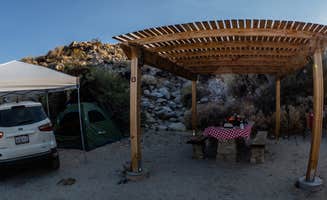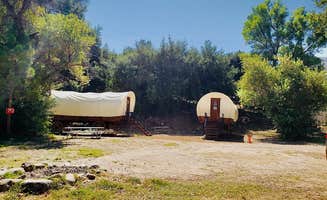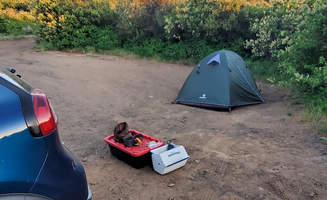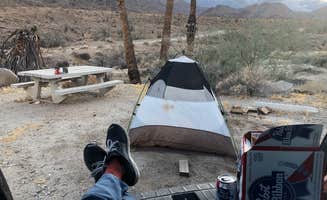Tent camping near Salton City, California provides opportunities to explore the desert's unique terrain at elevations ranging from -226 feet below sea level to higher desert mesas. The region features multiple dispersed camping areas with limited to no facilities, requiring campers to bring sufficient water supplies - at least one gallon per person per day during winter months and significantly more during summer. Winter temperatures average 65-75°F during day and 45-55°F at night, while summer temperatures frequently exceed 110°F.
What to do
Night sky viewing: Box Canyon Dispersed offers exceptional stargazing with minimal light pollution. As camper Joe C. notes about Box Canyon Dispersed: "Got my jeep deep into the canyon between coachella weekends and was the only person there," providing the isolation needed for clear night sky viewing.
Canyon exploration: The desert terrain features numerous canyons with unique geological formations. At Bow Willow Primitive Campground, Stephen B. mentions there's a "nice hike to a palm grove" where campers can experience native California fan palms in their natural habitat.
Wildlife observation: Early mornings and evenings provide opportunities to spot desert wildlife. At Tool Box Springs, one camper reports: "Lots of wildlife. Raccoons in the night, gray squirrel, other squirrels, many birds," making it ideal for nature enthusiasts.
Desert photography: The dramatic landscapes offer excellent photography conditions, especially during golden hour. Ralitsa K. from Bow Willow Primitive Campground mentions: "This campsite was first come first serve. We set up quickly and enjoyed ourselves a walk around the site," where unique desert formations provide photographic opportunities.
What campers like
Isolation and quiet: Many dispersed sites offer significant distance from other campers. At Pine Creek Road Camp, David reports: "A great spot if you want to get away and enjoy some alone time... My girlfriend and I stopped in Julian on our way out to get a late lunch and then head to the campsite... We never saw another person during our stay."
Natural springs: Some camping areas feature natural water sources, though these aren't suitable for drinking without treatment. Richard D. from Corn Springs Campground shares: "Great place to camp if you like the quiet peaceful desert. Old cabins up the wash and other fun things to explore."
Cultural sites: Several camping areas contain historical or archaeological features. At Corn Springs, Dan X. notes: "There's a little hike from the campground and an abandoned cabin to check out nearby," which provides historical context to the area.
Accessible primitive camping: Many sites balance remoteness with accessibility. Terry B. explains: "Cool place in the mountains. About 6 miles of dirt road, but fairly well maintained with minor washboarding. About 8-10 sites, most have level spots for car or tent."
What you should know
Heat management: Summer temperatures make camping dangerous without proper preparation. Jill E. from Ocotillo Wells State Vehicular Recreation Area warns: "It does get very hot bring plenty of water," emphasizing the need for adequate hydration in the desert environment.
Sand conditions: Many access roads and campsites feature deep sand that affects mobility. Sarah M. cautions about Box Canyon: "This is ideally a good spot, but the sand is way too deep to get far enough off of the road," highlighting the need for appropriate vehicles or camping gear.
Vehicle requirements: Access to most sites requires appropriate vehicles. Regarding Tool Box Springs, Kyle M. advises: "If it's been snowing or raining, you'll need high clearance and 4x4. And, be mindful that the drive is about 30-45 minutes up the mountain."
Seasonal considerations: Different seasons present unique challenges. Kris K. from Ocotillo Wells suggests: "Avoid big weekends and pack 3 times the amount of water that you think you would need," particularly important for holiday weekends when resources may be strained.
Tips for camping with families
Activity planning: Structure activities around cooler parts of the day. At Yaqui Wash, Abe C. notes: "It is well vegetated and allows for fairly easy hikes up the soft slopes... The parking spots are right alongside the road, so for van camping is not so great, but tents can be put away from the road and therefore it's much more suitable for tenting."
Site selection: Choose sites with some natural barriers for safety. For Los Coyotes Camp Cahuilla Reservation, Taylor reports: "This place was a lot of fun to camp. We traveled in a large group so finding sites large enough was my concern. This place was so big it had space for another 10 cars and tents."
Wildlife awareness: Teach children about desert wildlife safety. Richard D. shares a relevant experience: "One night we slept there it was so dang hot at night that we slept out on the ground with our dog as opposed to inside the camper van, only to be woken up and surrounded by coyotes."
Sun protection: Plan for shade structures as natural shade is limited. Geoff H. advises: "It can be very HOT, no matter what time of year so make sure you bring your shade," highlighting the importance of creating cooling spaces for children.
Tips from RVers
Level site finding: Look for compacted areas to avoid sinking. Nick A. from Box Canyon shares: "We had a great time. The kids did some exploring. Found a Geocache… we had two foxes come and visit the campsite... It was still warm during the day here in late November."
Site spacing awareness: Note that some areas have crowded weekend conditions. Jennifer D. reports: "I've mostly rv camped here during the annual Jeep event in March/April. We get there early to get a prime uncrowded spot for our caravan. No rv hookups and no shade as it's the desert."
Water conservation: Implement strict water usage rules. Kris K. emphasizes: "Great place to camp and offroad. Maps are easy to get and trails are well posted," but reminds campers to bring triple the expected water amount.
Weekend planning: Consider weekday camping for quieter experiences. Becca H. concludes: "They hand out trash bags and maps but somehow trash still ends up around all the campsites. The rangers are super kind and helpful! The roads are deep sand so it helps to have a vehicle that can handle it."


